
Bluefin tuna. Image from Pxhere, CC0.
Bluefin tuna, swordfish and Atlantic mackerel are among the fish species considered commercially extinct or extirpated on the Turkish side of the Marmara and Black Seas.
A new study by researchers with the Sea Around Us initiative at the University of British Columbia, Mersea Marine Conservation Consulting, Turkey’s Central Fisheries Research Institute and the Institute of Marine Sciences and Management at the University of Istanbul, found that 17 fish species have been extirpated and 17 are commercially extinct in Turkey’s Black Sea, while 19 have been extirpated and 22 went commercially extinct in the Sea of Marmara.
“Schools of bluefin tuna, for example, ceased migrating to the Black Sea in 1985, after the entire spawning group was caught in the Sea of Marmara in just one day for export to Japan at high prices,” said Aylin Ulman, lead author of the study, director of Mersea Marine Conservation Consulting and Sea Around Us/UBC alumna. “In the Sea of Marmara, bluefin catches were lastly reported in 2007 and it was just 33 tonnes, down from the 929 tonnes that were caught at the peak of the fishery in 2001.”
By reviewing fisheries data for the 1967-2016 period collected by the Turkish Statistical Institute or referenced in peer-reviewed publications, grey literature, anecdotal information, and by tapping into traditional ecological knowledge from fishers and experts, the researchers created the first timeline of disappeared fish species from the Turkish Black Sea and the Marmara Sea.
If a species was present in data from 1967 but no longer present in 2016, this was defined as an extirpation. Commercial extinction, on the other hand, was defined as a reduction of catch, over the 50 years period, of more than 80% of their original values. This means that the species ceased to support economically viable fisheries on their own.

Great white shark. Photo by Hermanus Backpackers, Wikimedia Commons.
“Overfishing has been the dominant stressor on these marine ecosystems and has led to the loss of ecological connections,” Ulman said. “The scale of biodiversity loss demonstrated here, however, cracked the foundations of these ecosystems, and has reduced their connectivity, as many migratory species are no longer linked to the Black Sea. Thus, once bluefin tuna was all fished and stopped its migration, it had a domino effect on other species, such as porbeagle sharks of which there have not been any sightings for several decades. Similarly, until 1980, great white sharks were caught in association with migrating bluefin tuna, their prey. Due to the local extinction of bluefin tuna from the Sea of Marmara in the 1980s, this shark is also assumed to be locally extinct.”
The review shows that the lack of a management plan has contributed to severe degradation of the Black Sea ecosystem, with a similar fate awaiting the Sea of Marmara, as both are intimately connected.
“Overfishing and ecological extinction of species usually precede the collapse of ecosystems, as resilience has been reduced by simplification of food webs,” said Daniel Pauly, co-author of the study and principal investigator of the Sea Around Us initiative at UBC’s Institute for the Oceans and Fisheries. “The overwhelming number of extirpated and commercially extinct species should be a call for ecosystem rehabilitation. It is not obvious that recovery is possible because the remaining populations are so small that the rebuilding potential is limited, but an attempt still ought to be made.”
In Pauly’s view, the protection from industrial fishing of the Bosphorus Strait that links the Black Sea with the Marmara Sea, and the Dardanelles Strait, which connects the Marmara Sea with the Aegean and Mediterranean Seas, could be an effective preliminary conservation target as they are of utmost importance in delivering function to these two seas.
The authors dedicate their study as a commemoration of the many lost species of the Black and Marmara Seas towards a warning call to prevent dozens of other species to join them.
The paper “The Lost Fish of Turkey: A Recent History of Disappeared Species and Commercial Fishery Extinctions for the Turkish Marmara and Black Seas” was published in Frontiers in Marine Science, doi: 10.3389/fmars.2020.00650


